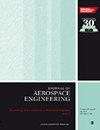Output feedback control for hypersonic flight vehicles via distributed high-gain observer
IF 1.1
4区 工程技术
Q3 ENGINEERING, AEROSPACE
Proceedings of the Institution of Mechanical Engineers Part G-Journal of Aerospace Engineering
Pub Date : 2024-05-02
DOI:10.1177/09544100241249346
引用次数: 0
Abstract
During the hypersonic flight process of rigid hypersonic flight vehicles (HFVs), the flight-path angle and angle of attack are usually small and sensitive to flight condition variation, the accurate measurements are difficult, subsequently the formulation of states observers is an urgent issue. A distributed high-gain observer is proposed to reconstruct the admissible system state dynamics based on limited measured output. First, a distributed observer is proposed for the cascade strict-feedback system to ensure the global convergence of the state estimation errors between the estimated state in each local observer and system states, for the prescribed system initial values. Second, the distributed high-gain observer-based nonlinear control is investigated on the longitudinal dynamics of HFVs with partial measurable states. The rigid body system dynamic is divided into the altitude subsystem and the velocity subsystem. In the altitude subsystem, the proposed distributed high-gain observer is formulated to exact estimate the flight-path angle and angle of attack, and then the back-stepping design is proposed for constructing the controllers. The nonlinear dynamic inversion controller is introduced to accomplish the velocity tracking. Finally, simulation examples are served to verify that the proposed output feedback control possesses the superior properties of high tracking performance, fast convergence of state estimation error and easy-implementation.通过分布式高增益观测器实现高超音速飞行器的输出反馈控制
在刚性高超声速飞行器(HFV)的高超声速飞行过程中,飞行轨迹角和攻角通常较小,且对飞行条件的变化非常敏感,精确测量十分困难,因此制定状态观测器是一个亟待解决的问题。本文提出了一种分布式高增益观测器,根据有限的测量输出重建可接受的系统状态动态。首先,针对级联严格反馈系统提出了分布式观测器,以确保在规定的系统初始值下,每个局部观测器的估计状态与系统状态之间的状态估计误差全局收敛。其次,研究了基于分布式高增益观测器的非线性控制对具有部分可测状态的高频变速器纵向动力学的影响。刚体系统动力学分为高度子系统和速度子系统。在高度子系统中,提出了分布式高增益观测器来精确估计飞行路径角和攻角,然后提出了反步进设计来构建控制器。引入非线性动态反演控制器来完成速度跟踪。最后,通过仿真实例验证了所提出的输出反馈控制具有跟踪性能高、状态估计误差收敛快和易于实现等优越性能。
本文章由计算机程序翻译,如有差异,请以英文原文为准。
求助全文
约1分钟内获得全文
求助全文
来源期刊

CiteScore
2.40
自引率
18.20%
发文量
212
审稿时长
5.7 months
期刊介绍:
The Journal of Aerospace Engineering is dedicated to the publication of high quality research in all branches of applied sciences and technology dealing with aircraft and spacecraft, and their support systems. "Our authorship is truly international and all efforts are made to ensure that each paper is presented in the best possible way and reaches a wide audience.
"The Editorial Board is composed of recognized experts representing the technical communities of fifteen countries. The Board Members work in close cooperation with the editors, reviewers, and authors to achieve a consistent standard of well written and presented papers."Professor Rodrigo Martinez-Val, Universidad Politécnica de Madrid, Spain
This journal is a member of the Committee on Publication Ethics (COPE).
 求助内容:
求助内容: 应助结果提醒方式:
应助结果提醒方式:


